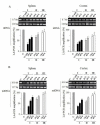Radioprotective and Radiomitigative Effects of Melatonin in Tissues with Different Proliferative Activity
- PMID: 34942988
- PMCID: PMC8698738
- DOI: 10.3390/antiox10121885
Radioprotective and Radiomitigative Effects of Melatonin in Tissues with Different Proliferative Activity
Abstract
We used various markers to analyze damage to mouse tissues (spleen and cerebral cortex) which have different proliferative activity and sensitivity to ionizing radiation (IR). We also assessed the degree of modulation of damages that occurs when melatonin is administered to mice prior to and after their X-ray irradiation. The data from this study showed that lesions in nuclear DNA (nDNA) were repaired more actively in the spleen than in the cerebral cortex of mice irradiated and treated with melatonin (N-acetyl-5-methoxytryptamine). Mitochondrial biogenesis involving mitochondrial DNA (mtDNA) synthesis was activated in both tissues of irradiated mice. A significant proportion of the newly synthesized mtDNA molecules were mutant copies that increase oxidative stress. Melatonin reduced the number of mutant mtDNA copies and the level of H2O2 in both tissues of the irradiated mice. Melatonin promoted the restoration of ATP levels in the tissues of irradiated mice. In the mouse tissues after exposure to X-ray, the level of malondialdehyde (MDA) increased and melatonin was able to reduce it. The MDA concentration was higher in the cerebral cortex tissue than that in the spleen tissue of the mouse. In mouse tissues following irradiation, the glutathione (GSH) level was low. The spleen GSH content was more than twice as low as that in the cerebral cortex. Melatonin helped restore the GSH levels in the mouse tissues. Although the spleen and cerebral cortex tissues of mice differ in the baseline values of the analyzed markers, the radioprotective and radiomitigative potential of melatonin was observed in both tissues.
Keywords: ATP; GSH; H2O2; MDA; melatonin; mitigation; mtDNA-mutations; nDNA-repair; oxidation stress; protection; radiation.
Conflict of interest statement
All authors declare no conflict of interest.
Figures







References
-
- Hall E.J., Giaccia A.J. Radiobiology for the Radiologist. 8th ed. Wolters Kluwer; Philadelphia, PA, USA: 2019.
-
- Reiter R.J., Tan D.X., Herman T.S., Thomas C.R., Jr. Melatonin as a radioprotective agent: A review. Int. J. Radiat. Oncol. Biol. Phys. 2004;59:639–653. - PubMed
LinkOut - more resources
Full Text Sources

